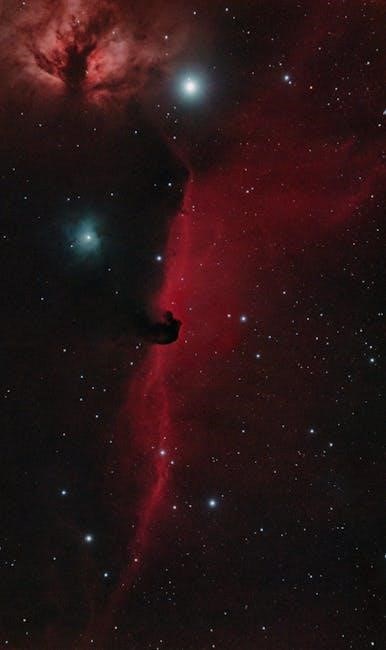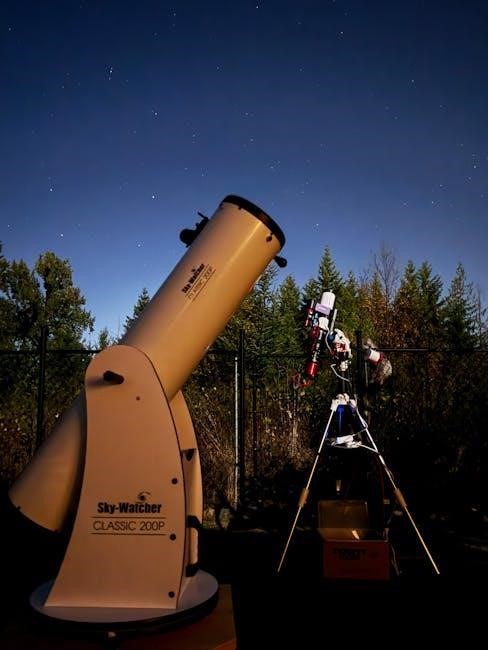Welcome to the Guide to the Stars, your essential companion for exploring the fascinating celestial bodies that illuminate our universe. This guide offers insights into the science, history, and observation of stars, helping you understand their significance and beauty.
1.1 What Are Stars?
Stars are massive, luminous celestial bodies primarily composed of hydrogen and helium, sustained by nuclear fusion in their cores. They emit energy in the form of light and heat, making them visible from great distances. Stars vary in size, color, and temperature, with sizes ranging from small, cool red dwarfs to enormous, hot blue giants. Our Sun is a G-type star, a medium-sized star that sustains life on Earth. Stars are born from collapsing clouds of gas and dust, and their life cycles vary based on mass. They are not static objects but dynamic systems undergoing constant change. Understanding stars helps us explore the universe’s structure and evolution, as they serve as cosmic laboratories for studying fundamental physics.
The study of stars reveals their role in creating elements essential for planetary formation and life. Their light guides us through the cosmos, making them vital for navigation and inspiration across cultures. Stars are not just points of light but complex entities with unique stories, shaping our understanding of the universe and humanity’s place within it.
1.2 The Importance of Studying Stars
Studying stars is crucial for understanding the universe’s fundamental laws of physics and chemistry. Stars provide insights into the behavior of matter under extreme conditions, such as high temperatures and pressures, which are impossible to replicate on Earth. By analyzing their light, scientists can determine their composition, temperature, and motion, offering clues about the universe’s history and evolution. Stars also serve as cosmic laboratories for studying nuclear reactions, which power their luminosity. Understanding stars helps us grasp the formation and structure of galaxies, including our own Milky Way. Additionally, the study of stars contributes to advancements in technology, such as spectroscopy and telescopes, which have broader applications in science and engineering. The knowledge gained from stars also informs the search for exoplanets and life beyond Earth, making stellar astronomy a cornerstone of modern astrophysics.
1.3 Brief History of Stellar Astronomy
The study of stars dates back to ancient civilizations, where early astronomers recognized constellations and tracked star movements to guide agriculture and navigation. The Babylonians, Greeks, and Chinese documented celestial patterns, laying the groundwork for modern astronomy. In the Renaissance, figures like Nicolaus Copernicus and Galileo Galilei revolutionized understanding with the heliocentric model and telescopic observations. Isaac Newton’s laws of motion and gravity provided a framework for understanding stellar mechanics. The 19th century introduced spectroscopy, allowing scientists to analyze starlight and determine chemical compositions. In the 20th century, Edwin Hubble’s discoveries expanded our understanding of the universe’s scale, while advancements in technology enabled detailed studies of star formation, life cycles, and properties. Today, stellar astronomy continues to evolve with space telescopes and computational models, revealing new insights into the cosmos.

The Life Cycle of Stars
The life cycle of stars begins with their formation, progresses through the main sequence stage, and ends with their death, often resulting in remnants like white dwarfs or supernovae;
2.1 The Birth of Stars
The birth of stars occurs within vast molecular clouds of gas and dust. These regions, dense and cold, collapse under gravity, forming dense cores. As the core spins, it flattens into a disk, with the center collapsing further into a protostar. Over millions of years, the protostar accretes material, eventually igniting nuclear fusion in its core, marking the star’s entry onto the main sequence. This process is crucial for understanding stellar evolution and the distribution of matter in galaxies. The conditions in these clouds determine the star’s mass and future characteristics, making the birth of stars a foundational topic in astrophysics.
- Star formation begins in molecular clouds.
- Gravity drives the collapse of these clouds.
- Protostars form and eventually ignite nuclear fusion.
2.2 The Main Sequence Stage

The main sequence stage is the longest phase in a star’s life, where it fuses hydrogen into helium in its core. This stable period can last millions to billions of years, depending on the star’s mass. More massive stars burn fuel faster, while smaller stars like red dwarfs can persist for trillions of years. During this phase, stars balance gravitational contraction with thermal pressure, maintaining equilibrium. The Sun is currently in this stage, expected to remain here for about 5 billion more years. Understanding the main sequence is key to studying stellar evolution, as it represents the most stable and predictable phase of a star’s life cycle.
- Stars spend 90% of their lifetime on the main sequence.
- Mass determines the duration of this phase.
- Nuclear fusion sustains the star’s energy output.
2.3 The Red Giant Phase
The red giant phase marks a significant transformation in a star’s life cycle. As hydrogen in the core depletes, the core contracts, and the outer layers expand, causing the star to swell dramatically. This phase occurs after the main sequence stage and is characterized by the star becoming brighter and cooler, turning a reddish hue. For stars like the Sun, this expansion can engulf nearby planets. During this phase, helium fusion begins in the core, creating heavier elements. Eventually, the star sheds its outer layers, forming a planetary nebula, while the core collapses into a white dwarf. The red giant phase is a critical transition before the star’s final stages of evolution.
- The star expands up to 100 times its original size.
- Helium fusion ignites in the core.
- The Sun will enter this phase in about 5 billion years.
2.4 The Death of Stars: Supernovae and White Dwarfs
The death of stars marks the end of their life cycle, with outcomes varying by mass; Massive stars explode as supernovae, ejecting elements like iron and heavier metals into space, enriching interstellar gas. This explosive finale leaves behind either a neutron star or black hole. Less massive stars, like the Sun, shed their outer layers, forming a planetary nebula, while the core becomes a white dwarf. White dwarfs are dense, Earth-sized remnants that slowly cool over billions of years. Supernovae are crucial for creating heavy elements necessary for planetary formation and life. Both processes signify the star’s final transformation, ending its nuclear fusion and scattering its materials into the cosmos.

- Supernovae expel heavy elements formed during fusion.
- White dwarfs are dense cores that no longer generate energy.
- Planetary nebulae result from a star’s outer layers being shed.

Types of Stars
Stars vary by mass, temperature, and composition, leading to diverse classifications.
- Spectral types: O, B, A, F, G, K, M.
- Unique types: brown dwarfs, neutron stars, black holes.
- Binary and multiple star systems exist.
3.1 Classification by Spectral Type: O, B, A, F, G, K, M
The classification of stars by spectral type is based on their temperature, color, and spectral lines. The sequence, from hottest to coolest, is O, B, A, F, G, K, and M. O-type stars are extremely hot, blue, and luminous, while M-type stars are cooler, reddish, and less luminous. G-type stars, like our Sun, are moderate in temperature and are the most common. This system, developed by Annie Jump Cannon, helps astronomers understand a star’s surface temperature, composition, and evolutionary stage. Each spectral class is further divided into subclasses, providing a detailed catalog of stellar properties; This classification is fundamental for studying stars and their roles in the universe.
- O-type: Hottest, blue, highly luminous.
- B-type: Hot, blue, very bright.
- A-type: Blue-white, intense light.
- F-type: White, moderate temperature.
- G-type: Yellow, like the Sun.
- K-type: Orange, cooler than G-type.
- M-type: Reddest, coolest, and most numerous.
This system aids in identifying stars’ characteristics and their life cycles.
3.2 Unique Types of Stars: Brown Dwarfs, Neutron Stars, and Black Holes
Brown dwarfs are often referred to as “failed stars” because they do not sustain nuclear fusion. They emit primarily infrared radiation and are cooler and less massive than main-sequence stars. Neutron stars, formed from supernovae, are incredibly dense and exhibit strong magnetic fields, often leading to phenomena like pulsars. Black holes, formed from massive star collapses, have gravitational pulls so strong that not even light escapes, with types ranging from stellar to supermassive. Hawking radiation theory suggests black holes emit radiation near their event horizons. These unique celestial entities offer insights into extreme astrophysical conditions and gravitational forces.
- Brown Dwarfs: Failed stars emitting infrared radiation.
- Neutron Stars: Dense remnants with strong magnetic fields and pulsar phenomena.
- Black Holes: Regions with inescapable gravity, varying in size, and theoretical Hawking radiation.
These unique types of stars are crucial for understanding astrophysical extremes and gravitational dynamics.
3.3 Binary and Multiple Star Systems
Binary and multiple star systems consist of two or more stars gravitationally bound together. These systems form during the collapse of star-forming molecular clouds. Binary stars can be close, with stars transferring mass, or wide, orbiting at great distances. Multiple systems include triple or more stars, often in hierarchical configurations for stability. Eclipsing binaries, where stars pass in front of each other, help determine stellar sizes and masses. These systems offer insights into star formation and evolution, with some producing phenomena like X-ray binaries or pulsars. Observing these systems enhances our understanding of gravitational interactions and stellar dynamics in the universe.
- Binary Systems: Two stars orbiting a common center of mass.
- Multiple Systems: Three or more stars in gravitational interaction.
- Stability: Hierarchical structures prevent chaotic interactions.
- Scientific Value: Key to studying star formation and evolution.

Observing the Stars
Observing the stars offers a fascinating glimpse into the universe, requiring essential equipment and knowledge of best practices to enhance the stargazing experience for both amateurs and professionals.
4.1 Essential Equipment for Stargazing
Stargazing requires the right tools to enhance your experience. A good pair of binoculars or a telescope is essential for observing distant stars and celestial objects. Telescopes come in types like reflector or refractor, each offering unique advantages. Star charts or planisphere maps help identify constellations and locate specific stars; A red light flashlight preserves night vision, while a sturdy tripod ensures stability for equipment. Downloading stargazing apps like Sky Map or Stellarium can guide you in real-time. For serious enthusiasts, accessories like eyepieces and filters expand observational capabilities. Investing in quality equipment ensures clearer views and a deeper appreciation of the night sky. Modern technology has made stargazing more accessible, allowing everyone to explore the universe with precision and enjoyment.
4.2 Best Locations for Star Observation
The best locations for stargazing are those with minimal light pollution and clear skies. Remote areas like national parks, deserts, and high-altitude sites offer ideal conditions. Places such as the Atacama Desert in Chile, Mauna Kea in Hawaii, and La Palma in the Canary Islands are renowned for their exceptional stargazing opportunities. In the U.S., locations like Great Basin National Park and Death Valley are popular due to their dark skies. Avoid cities and urban areas, as light pollution obscures the view. Timing your visits during new moons further enhances visibility. Consider attending star parties or visiting observatories for guided experiences. Always respect local regulations and preserve the natural darkness of these sites for future stargazers.
4.3 Timing Your Observations: Seasonal and Celestial Events
Timing your stargazing sessions is crucial for maximizing the experience. Seasonal changes play a significant role, as certain constellations are visible only during specific times of the year. For example, winter offers stunning views of Orion, while summer highlights Scorpio. Celestial events like meteor showers, such as the Perseid meteor shower in August, provide spectacular displays. Lunar eclipses and planetary alignments also offer rare opportunities for observation. The best viewing times often coincide with a new moon, as the absence of moonlight enhances visibility. Avoid full moons, as they can overpower fainter stars and celestial phenomena. Additionally, solar events like equinoxes and solstices align Earth’s axis in ways that reveal unique astronomical sights. Planning observations around these events ensures a more rewarding and enriching stargazing experience.

Stellar Phenomena
Explore the fascinating world of stellar phenomena, including supernovae, solar flares, and celestial light shows, revealing the dynamic nature of the cosmos and its many wonders.
5.1 Eclipses: Solar and Lunar
Eclipses are rare and awe-inspiring events where the Moon temporarily blocks the Sun’s light (solar eclipse) or the Earth blocks the Sun’s light from reaching the Moon (lunar eclipse); Solar eclipses occur when the Moon’s shadow falls on Earth, while lunar eclipses happen when Earth’s shadow covers the Moon. There are three types of solar eclipses: total, partial, and annular, depending on how much of the Sun is obscured. Lunar eclipses can be total, partial, or penumbral. Eclipses are significant for scientific study, offering insights into the Sun’s corona and the Earth-Moon system. They also hold cultural and historical importance, often inspiring wonder and curiosity. Observing solar eclipses requires special eye protection, while lunar eclipses are safe to view with the naked eye. Eclipses are relatively rare due to the precise alignment required, making them a unique experience for stargazers worldwide.
5.2 Auroras: Northern and Southern Lights
Auroras, known as the Northern Lights (Aurora Borealis) and Southern Lights (Aurora Australis), are breathtaking natural light displays in the polar skies. They occur when charged particles from the Sun interact with Earth’s magnetic field and atmosphere. The particles excite oxygen and nitrogen atoms, causing them to emit light at specific wavelengths, resulting in vibrant colors. Green is the most common, while red appears at higher altitudes, and blue or purple occurs near the horizon. Auroras can appear as dancing curtains, coronal crowns, or diffuse glows. They are most visible near the Arctic and Antarctic but can occasionally be seen at lower latitudes during strong solar activity. Unique forms, like “STEVE” (a narrow, east-west moving ribbon of light), have been documented. Auroras are a reminder of Earth’s dynamic interaction with space and inspire scientific study and wonder. Observing them is a magical experience for many.
5;3 Meteor Showers and Their Origins
Meteor showers occur when Earth passes through trails of debris left by comets or asteroids. As these small particles enter Earth’s atmosphere at high speeds, they burn up, creating bright streaks in the sky. Showers are named after the constellation from which the meteors appear to originate, such as the Perseid meteor shower, which radiates from the constellation Perseus. The debris trails are often remnants of comets that have disintegrated over time. Popular showers include the Geminids, Leonids, and Orionids, each with distinct peak times. Meteor showers are a thrilling spectacle for stargazers, offering a glimpse into the cosmic interactions that shape our solar system. Observing them is best done under dark skies, away from light pollution, to maximize the viewing experience.
5.4 Solar Flares and Their Impact on Earth
Solar flares are intense bursts of radiation from the Sun’s surface, often linked to magnetic storms. They emit vast amounts of X-rays and UV radiation that can affect Earth. When these emissions interact with Earth’s magnetic field, they cause geomagnetic storms. These storms can disrupt communication systems, interfere with satellite operations, and cause power grid fluctuations. Solar flares are classified by intensity, with C, M, and X classes, where X-class flares are the most powerful. Historically, significant solar flares have caused widespread power outages, such as the 1859 Carrington Event. Understanding and monitoring solar flares are crucial for mitigating their effects on Earth’s infrastructure and communication networks, especially with our increasing reliance on technology.

The Cultural Significance of Stars
Stars have profoundly shaped human culture, inspiring mythology, art, and spirituality. They symbolize hope, guidance, and wonder, connecting us to our past and defining our identity.
6.1 Constellations and Their Mythological Stories
Constellations, groups of stars forming patterns, have been central to human mythology and storytelling across cultures. Ancient civilizations like the Greeks, Romans, and Norse peoples wove tales around these celestial arrangements, often linking them to their gods, heroes, and legends. For example, the constellation Orion is associated with the Greek hunter Orion, while Cassiopeia represents the vain queen in Norse mythology. These stories not only entertained but also served as tools for teaching moral lessons, explaining natural phenomena, and preserving cultural heritage. Many constellations are still recognized today, bridging the gap between ancient myths and modern stargazing. Their enduring appeal highlights humanity’s deep connection to the night sky and its ability to inspire imagination and wonder. By studying these stories, we gain insights into the beliefs and values of our ancestors, making constellations a timeless link to our shared cultural past.
6.2 The Zodiac and Astrology
The zodiac, a circle of twelve constellation groups, forms the foundation of astrology, a belief system linking celestial positions to human affairs. Each zodiac sign corresponds to specific traits and a time period, influencing personality and destiny. Astrology, with roots in ancient Mesopotamia, was refined by the Greeks, who tied it to mythology and cosmic harmony. Despite lacking scientific backing, astrology remains popular, offering insights and guidance. Its cultural impact is profound, shaping art, literature, and daily decisions, making it a significant aspect of human history and identity, even as its validity is debated.
6.3 The Role of Stars in Navigation and Ancient Cultures
Stars have long served as vital navigational tools, guiding explorers and mariners across vast distances. Ancient cultures relied on constellations like Ursa Major and Orion to determine direction and season. The North Star, or Polaris, was particularly crucial for navigation in the Northern Hemisphere. Beyond practical uses, stars deeply influenced ancient societies, shaping their spiritual beliefs, myths, and agricultural practices. Many cultures aligned their temples and monuments with celestial patterns, such as Stonehenge and the Pyramids, reflecting their reverence for the cosmos. Stars also inspired calendars, festivals, and myths, embedding themselves into the fabric of human history and identity.

Resources for Further Learning
Explore books, online courses, apps, and astronomy communities to deepen your understanding of stars and stellar phenomena, enhancing your knowledge and engagement with the cosmos.
7.1 Recommended Books and Online Courses
by the University of Arizona and “Astrophysics for People in a Hurry” by Neil deGrasse Tyson. These resources provide comprehensive insights into stellar formation, evolution, and cultural significance, catering to both beginners and advanced learners. Additionally, websites like Khan Academy and NASA’s educational portal offer free, engaging materials to supplement your learning journey. These tools will enhance your knowledge of the cosmos and inspire further exploration of the stars and their mysteries.
7.2 Star-Gazing Apps and Software
Enhance your stargazing experience with apps like Sky Map and Star Walk, which help identify constellations and celestial objects in real time. For planning observations, SkySafari offers detailed star charts and event notifications. Stellarium is a powerful planetarium software that simulates the night sky from any location. Apps like Photopills assist with astrophotography planning, while Heavens-Above provides precise satellite and meteor shower predictions. Tools like StarTracker and Celestron offer augmented reality features for a immersive experience. Many of these tools are available on iOS, Android, and desktop, making stargazing accessible and engaging for everyone. They are invaluable resources for both casual observers and serious astronomy enthusiasts, helping to deepen your connection to the stars and the universe.
7.3 Astronomy Communities and Events

Astronomy communities and events offer a great way to connect with fellow enthusiasts and deepen your knowledge of the stars. Local astronomy clubs often host stargazing sessions, workshops, and guest lectures by experts. Events like Star Parties bring together amateurs and professionals to observe the night sky collectively. Festivals such as AstroFest and Stellafane celebrate astronomy with exhibits, talks, and viewing opportunities. Online forums and groups, like Reddit’s r/Astronomy, provide platforms for sharing experiences and learning. Additionally, global events like Global Astronomy Month and World Space Week unite people worldwide in celebrating the cosmos. These communities and events foster a sense of belonging and inspire further exploration of the universe, making astronomy accessible and enjoyable for everyone.
